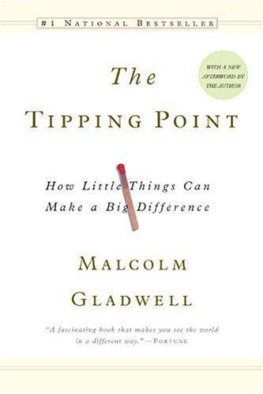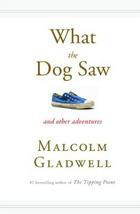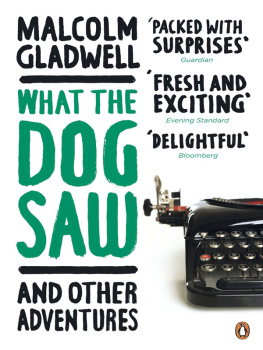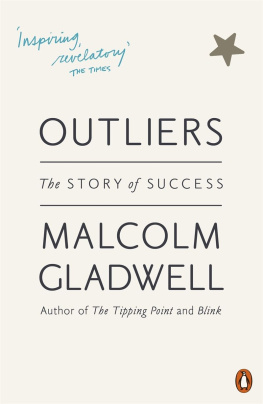Malcolm Gladwell - Theories, Predictions, and Diagnoses: Part Two from What the Dog Saw
Here you can read online Malcolm Gladwell - Theories, Predictions, and Diagnoses: Part Two from What the Dog Saw full text of the book (entire story) in english for free. Download pdf and epub, get meaning, cover and reviews about this ebook. year: 2009, publisher: Little, Brown and Company, genre: Detective and thriller. Description of the work, (preface) as well as reviews are available. Best literature library LitArk.com created for fans of good reading and offers a wide selection of genres:
Romance novel
Science fiction
Adventure
Detective
Science
History
Home and family
Prose
Art
Politics
Computer
Non-fiction
Religion
Business
Children
Humor
Choose a favorite category and find really read worthwhile books. Enjoy immersion in the world of imagination, feel the emotions of the characters or learn something new for yourself, make an fascinating discovery.

- Book:Theories, Predictions, and Diagnoses: Part Two from What the Dog Saw
- Author:
- Publisher:Little, Brown and Company
- Genre:
- Year:2009
- Rating:3 / 5
- Favourites:Add to favourites
- Your mark:
- 60
- 1
- 2
- 3
- 4
- 5
Theories, Predictions, and Diagnoses: Part Two from What the Dog Saw: summary, description and annotation
We offer to read an annotation, description, summary or preface (depends on what the author of the book "Theories, Predictions, and Diagnoses: Part Two from What the Dog Saw" wrote himself). If you haven't found the necessary information about the book — write in the comments, we will try to find it.
Theories, Predictions, and Diagnoses: Part Two from What the Dog Saw — read online for free the complete book (whole text) full work
Below is the text of the book, divided by pages. System saving the place of the last page read, allows you to conveniently read the book "Theories, Predictions, and Diagnoses: Part Two from What the Dog Saw" online for free, without having to search again every time where you left off. Put a bookmark, and you can go to the page where you finished reading at any time.
Font size:
Interval:
Bookmark:
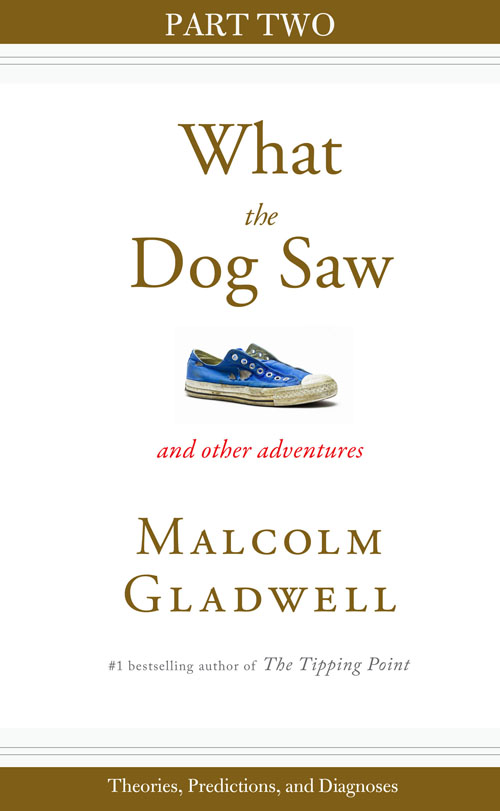
Copyright 2009 by Malcolm Gladwell
All rights reserved. Except as permitted under the U.S. Copyright Act of 1976, no part of this publication may be reproduced, distributed, or transmitted in any form or by any means, or stored in a database or retrieval system, without the prior written permission of the publisher.
Little, Brown and Company
Hachette Book Group
237 Park Avenue
New York, NY 10017
Visit our website at www.HachetteBookGroup.com.
www.twitter.com/littlebrown.
First eBook Edition: October 2009
Little, Brown and Company is a division of Hachette Book Group, Inc. The Little, Brown name and logo are trademarks of Hachette Book Group, Inc.
Essays previously published in The New Yorker.
ISBN: 978-0-316-08615-8
Outliers
Blink
The Tipping Point
For Henry and David

When I was a small child, I used to sneak into my fathers study and leaf through the papers on his desk. He is a mathematician. He wrote on graph paper, in pencil long rows of neatly written numbers and figures. I would sit on the edge of his chair and look at each page with puzzlement and wonder. It seemed miraculous, first of all, that he got paid for what seemed, at the time, like gibberish. But more important, I couldnt get over the fact that someone whom I loved so dearly did something every day, inside his own head, that I could not begin to understand.
This was actually a version of what I would later learn psychologists call the other minds problem. One-year-olds think that if they like Goldfish Crackers, then Mommy and Daddy must like Goldfish Crackers, too: they have not grasped the idea that what is inside their head is different from what is inside everyone elses head. Sooner or later, though, children come to understand that Mommy and Daddy dont necessarily like Goldfish, too, and that moment is one of the great cognitive milestones of human development. Why is a two-year-old so terrible? Because she is systematically testing the fascinating and, to her, utterly novel notion that something that gives her pleasure might not actually give someone else pleasureand the truth is that as adults we never lose that fascination. What is the first thing that we want to know when we meet someone who is a doctor at a social occasion? It isnt What do you do? We know, sort of, what a doctor does. Instead, we want to know what it means to be with sick people all day long. We want to know what it feels like to be a doctor, because were quite sure that it doesnt feel at all like what it means to sit at a computer all day long, or teach school, or sell cars. Such questions are not dumb or obvious. Curiosity about the interior life of other peoples day-to-day work is one of the most fundamental of human impulses, and that same impulse is what led to the writing you now hold in your hands.
All the pieces in What the Dog Saw come from the pages of The New Yorker, where I have been a staff writer since 1996. Out of the countless articles Ive written over that period, these are my favorites. Ive grouped them into three categories. The first section is about obsessives and what I like to call minor geniuses not Einstein and Winston Churchill and Nelson Mandela and the other towering architects of the world in which we live, but people like Ron Popeil, who sold the Chop-O-Matic, and Shirley Polykoff, who famously asked, Does she or doesnt she? Only her hairdresser knows for sure. The second section is devoted to theories, to ways of organizing experience. How should we think about homelessness, or financial scandals, or a disaster like the crash of the Challenger? The third section wonders about the predictions we make about people. How do we know whether someone is bad, or smart, or capable of doing something really well? As you will see, Im skeptical about how accurately we can make any of those judgments.
In the best of these pieces, what we think isnt the issue. Instead, Im more interested in describing what people who think about homelessness or ketchup or financial scandals think about homelessness or ketchup or financial scandals. I dont know what to conclude about the Challenger crash. Its gibberish to me neatly printed indecipherable lines of numbers and figures on graph paper. But what if we look at that problem through someone elses eyes, from inside someone elses head?
You will, for example, come across an article in which I try to understand the difference between choking and panicking. The piece was inspired by John F. Kennedy Jr.s fatal plane crash in July of 1999. He was a novice pilot in bad weather who lost the horizon (as pilots like to say) and went into a spiral dive. To understand what he experienced, I had a pilot take me up in the same kind of plane that Kennedy flew, in the same kind of weather, and I had him take us into a spiral dive. It wasnt a gimmick. It was a necessity. I wanted to understand what crashing a plane that way felt like, because if you want to make sense of that crash, its simply not enough to just know what Kennedy did. The Picture Problem is about how to make sense of satellite images, like the pictures the Bush administration thought it had of Saddam Husseins weapons of mass destruction. I got started on that topic because I spent an afternoon with a radiologist looking at mammograms, and halfway through completely unprompted he mentioned that he imagined that the problems people like him had in reading breast X-rays were a lot like the problems people in the CIA had in reading satellite photos. I wanted to know what went on inside his head, and he wanted to know what went on inside the heads of CIA officers. I remember, at that moment, feeling absolutely giddy. Then theres the article after which this book is named. Its a profile of Cesar Millan, the so-called dog whisperer. Millan can calm the angriest and most troubled of animals with the touch of his hand. What goes on inside Millans head as he does that? That was what inspired me to write the piece. But after I got halfway through my reporting, I realized there was an even better question: When Millan performs his magic, what goes on inside the dogs head? Thats what we really want to know what the dog saw.
The question I get asked most often is, Where do you get your ideas? I never do a good job of answering that. I usually say something vague about how people tell me things, or my editor, Henry, gives me a book that gets me thinking, or I say that I just plain dont remember. When I was putting together this collection, I thought Id try to figure that out once and for all. There is, for example, a long and somewhat eccentric piece in this book on why no has ever come up with a ketchup to rival Heinz. (How do we feel when we eat ketchup?) That idea came from my friend Dave, who is in the grocery business. We have lunch every now and again, and he is the kind of person who thinks about things like that. (Dave also has some fascinating theories about melons, but thats an idea Im saving for later.) Another article, called True Colors, is about the women who pioneered the hair color market. I got started on that because I somehow got it in my head that it would be fun to write about shampoo. (I think I was desperate for a story.) Many interviews later, an exasperated Madison Avenue type said to me, Why on earth are you writing about shampoo? Hair color is much more interesting. And so it is.
Font size:
Interval:
Bookmark:
Similar books «Theories, Predictions, and Diagnoses: Part Two from What the Dog Saw»
Look at similar books to Theories, Predictions, and Diagnoses: Part Two from What the Dog Saw. We have selected literature similar in name and meaning in the hope of providing readers with more options to find new, interesting, not yet read works.
Discussion, reviews of the book Theories, Predictions, and Diagnoses: Part Two from What the Dog Saw and just readers' own opinions. Leave your comments, write what you think about the work, its meaning or the main characters. Specify what exactly you liked and what you didn't like, and why you think so.


